As tension rises in Jerusalem, Israelis stay away and debate how to resolve problems there while ignoring the West Bank and Gaza. It can’t be done.

It has become common over the last few days to hear that, ironically, the political Right is dividing Jerusalem and not the Left, putting up blockades around Palestinian neighborhoods in response to a spate of attacks. But after two visits to the city this week, it feels like this isn’t just about separating the Palestinian and Israeli neighborhoods — Jerusalem is increasingly divided from Israel itself.
Last week, a colleague who works in Jerusalem proposed a meeting at a Tel Aviv café – he said he wouldn’t dream of dragging anyone to Jerusalem these days. A friend had planned her son’s Bar Mitzvah at the Western Wall, but moved it to Rehovot south of Tel Aviv. After attending a peace demonstration in Jerusalem Saturday night, I returned on Monday to speak on a panel. Organizers were worried about attendance. Apparently some people planning to travel from elsewhere had canceled, saying they had families and couldn’t take the risk.
Due to road work, cellular navigation apps automatically route drivers to Highway 443, which runs through the West Bank, rather than the main road from Tel Aviv. There have been scattered attacks on Highway 443 in recent months, but I decided to take it anyway, keeping my mind on the statistical odds. The road was empty – it could have been 2 a.m.
I have never seen less daytime traffic on the ring road around Jerusalem, or in the perennial car-swamp area of Talpiot. Only later, stuck in long strings of vehicles inching out of Palestinian neighborhoods, did I realize that Palestinian and Jewish areas that are adjacent, or intertwined, are one big jam.
I drove to the sprawling neighborhood of Jabel Mukaber to see the fresh-looking concrete panels that had been erected the previous day, a harbinger of more walls running through the city. The area lies next to the Jewish neighborhood Armon Hanatsiv –formally called East Talpiot. The website of Jerusalem’s municipality writes: “The construction policy [in East Talpiot] emphasizes the establishment of satellite neighborhoods to boost the Jewish population of the city, making it unnecessary of build additional… Jewish neighborhoods in the city.”
The lovely, landscaped promenade in Armon Hanatsiv overlooks the Old City. It is now dotted with olive-uniformed Border Police officers, jeeps and swirling lights. I turn down a lumpy and gouged road that descends sharply towards one part of Jabel Mukaber. When a car approaches in the other direction, one of us had to stop – there was no room for two cars. By the road there is a small cluster of young guys hanging around, tinkering with an open engine.
I address one of them in English, hoping for directions. He asks me to switch to Hebrew, and explains that the wall was in a different part of the neighborhood. In this part, he says, things are quiet. “I don’t go to al-Aqsa, so everything is OK. Why go?” he says. “I don’t pray. I drink. I used to live in Tel Aviv, for three years – I worked at the bar at Oman 17” – a legendary Tel Aviv mega club – “and I loved that.”
How will all this violence end? I ask. “Just let people move around,” he says, sheepishly. Israeli officials say the new wall is only temporary; I ask if he thinks it may actually become permanent. “There are Jews there,” he answers. “Where there are Jews, they will not have a wall.”
He holds traffic while I make an awkward three-point turn and climb back up the road.
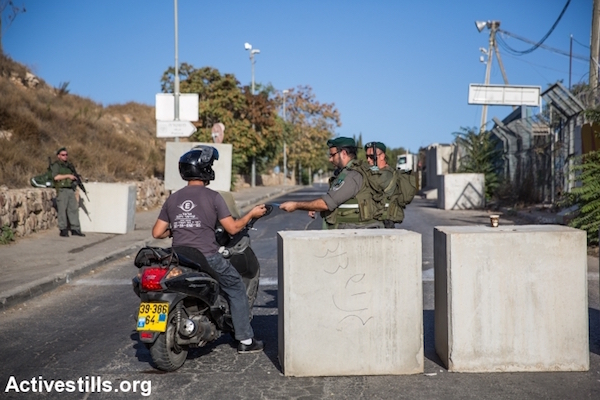
At the other entrance to Jabel Mukaber there are enormous concrete cubes in the street, placed so cars have to weave slowly around them. A group of heavily armed Border Police eye all the cars, stopping some.
The few shops are empty. Two Palestinian men are sitting outside a grocery silently. The older one reflexively hands me half of the orange he has just peeled. The other is drinking a beer. I ask how they feel, but they aren’t much in the mood for conversation. The older one gazes at me sullenly and says a few halting words in English. “What do you think?”
The tall white slabs, a sort of disembodied piece of wall, have been plunked down right on a corner. Behind them a newly constructed house, nearly completed, is now practically sealed off from the street.
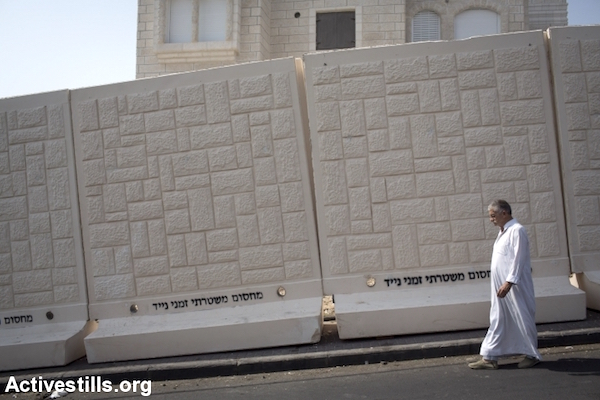
The other side of the street is Armon Hanatsiv. Border Police sit on that side, looking down on the scattered people, a large Israeli flag hung over them on a fence. It looms in front of anyone emerging from Jabel Mukaber.
At the turnoff where the piece of a wall stands there is a second barrier. The massive gray blocks are placed closer together so that vehicles cannot pass. The openings are slim even for a person.
Something happens when you cross the blocks. There is a sense of being in a different country, world, or planet. It is oddly quiet, since there is no traffic. The physical landscape is ragged — blackened rubbish and overturned trash bins line the road along with small rocks and a traces of a burnt stench.
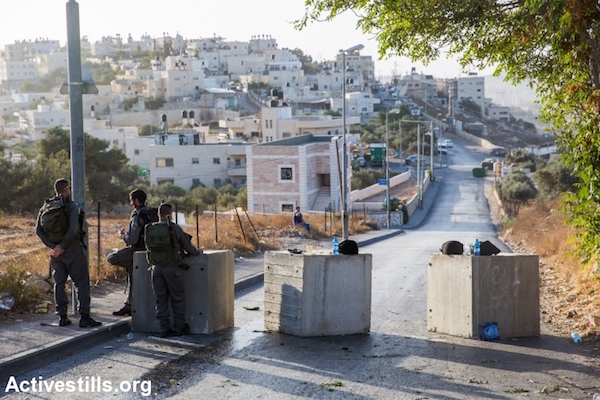
Four women in head coverings are waiting by the blockade. One of them, Nisreen, tells me they teach in a school here, but they live in different neighborhoods. They had to park some distance away because of the new barrier, so they are are waiting to be picked up by friends and driven back to their cars.
A steady trickle of drivers arrives from the main street. They approach the turnoff, peer out the window at the blocks, and curse. Where will they go? I ask an older man from the neighborhood. “The long way around. Maybe down the small road. Maybe they will have an accident.” I think of the steep gouged downhill road that couldn’t handle two cars side by side.
Behind her smart eye makeup and hijab, Nisreen looks weary. Everyone is scared, all the time, she says. “It’s not comfortable to walk around and have police pointing guns at your head.” She adds, “in America, do you see the videos of what is happening here? Do you see how the soldiers sometimes even pass things to one another, and pass a knife and put it by the person they killed?”
After she leaves, a platoon suddenly appears. Roughly 20 Border Police officers and navy-clad police special forces brandish weapons in the air, stride past the tight blockade and into the residential neighborhood. One of them wears a black mask over his face.
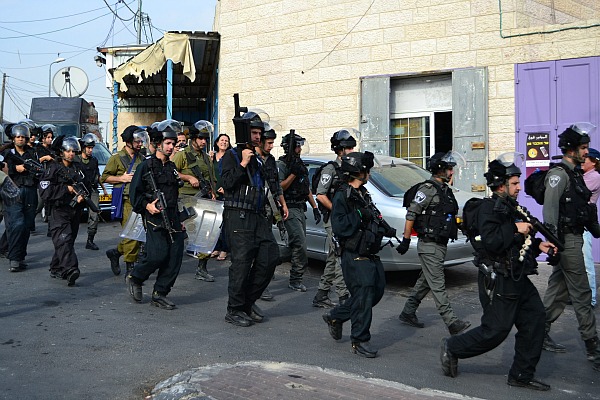
Some fan out in loose lines. The others disappear into the streets.
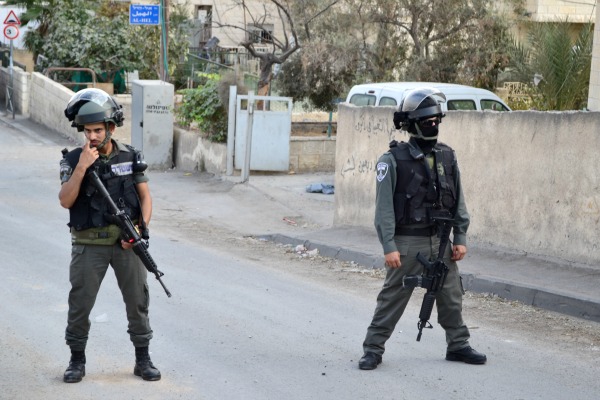
A routine is quickly established: The outer line stops every Palestinian who wants to go home, people returning after school, from university or their jobs. Each person – while I was there, mostly men – walks toward the soldiers. They motion to stop. He points and says, but I live right there. Just to the left, just to the right, just a few houses down. The soldiers say “five minutes” – all in Hebrew.
The men stand still as they talk, making no sudden moves. They step back and wait. Some children are let through. Eventually the soldiers call one, look at his papers, then yell or use their devices to tell the next line down that the person is approved to go home. A few minutes later another one is allowed, and so on.
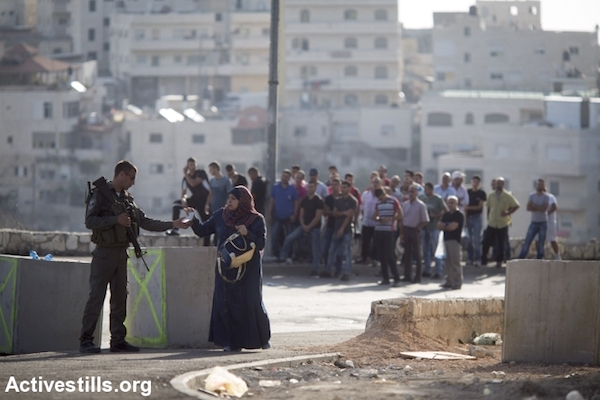
One of them is a nursing student in Bir Zeit university. He says he doesn’t know what the soldiers might be doing, but like a few others waiting around, he guesses they are measuring a house prior to demolition, or serving a demolition order.
It is hot and unusually humid for Jerusalem. Time, or something, ticks slowly as we stand there; finally, a soldier motions for him to come over. He talks to the student, looks at his papers, and pats his back as he allows him to walk through.
This is a quiet day: only one Palestinian, an older woman, has died at a checkpoint.
The rest of the day in the rest of Jerusalem is normal, but quiet. The swirling police lights are everywhere; sirens echo regularly through the hills.
Israelis appear agitated about the changing reality in the city. There has been speculation in the press about how to solve Jerusalem: grant the Palestinian residents full citizenship? Get rid of the neighborhoods, hand those areas to the West Bank authorities (whoever they are), and revoke Israeli permanent residency from the Palestinians there?
The problem is, that’s like asking how to solve Gaza: it can’t be done. There can be no resolution by addressing only one piece of the Palestinian community. The disengagement plan from Gaza failed because it was isolated from any larger political vision. The separation policy between Gaza and the West Bank failed to break the notion of a cohesive Palestinian entity in half and it cannot be broken into thirds. No wall, full patriation, or “getting rid” of Jerusalemites will make a genuine difference until the overall political, civil, human rights and humanitarian problem of the Palestinian people is addressed. The Israeli leadership steadfastly resists knowing this.
In the meantime, Jerusalem at present looks like mini-police state isolated from the rest of Israel. And it is already cut off for the majority of West Bank Palestinians by a strict permit regime.
It turned out that the German moderator of the panel event lives in Bonn. She and her husband explained that the city is still sore over losing its status as capital following reunification. The large-scale government infrastructure remains, six ministries and other venues such as an opera house far beyond what Bonn can fill. It sounds to me like a ghost capital, I said. Yes! They agreed. That is how it feels.
I left Jerusalem wondering whether it is a ghost-capital of a different sort in the making.

